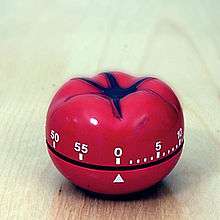Pomodoro Technique

The Pomodoro Technique is a time management method developed by Francesco Cirillo in the late 1980s.[1] The technique uses a timer to break down work into intervals, traditionally 25 minutes in length, separated by short breaks. These intervals are named pomodoros, the plural in English of the Italian word pomodoro (tomato), after the tomato-shaped kitchen timer that Cirillo used as a university student.[2][3] The method is based on the idea that frequent breaks can improve mental agility.[4][5]
Closely related to concepts such as timeboxing and iterative and incremental development used in software design, the method has been adopted in pair programming contexts.[6]
Underlying principles
There are six steps in the technique:
- Decide on the task to be done.
- Set the pomodoro timer (traditionally to 25 minutes).[1]
- Work on the task until the timer rings. If a distraction pops into your head, write it down, but immediately get back on task.
- After the timer rings, put a checkmark on a piece of paper.[7]
- If you have fewer than four checkmarks, take a short break (3–5 minutes), then go to step 1.
- After four pomodoros, take a longer break (15–30 minutes), reset your checkmark count to zero, then go to step 1.
The stages of planning, tracking, recording, processing and visualizing are fundamental to the technique. In the planning phase tasks are prioritized by recording them in a "To Do Today" list. This enables users to estimate the effort tasks require. As pomodoros are completed, they are recorded, adding to a sense of accomplishment and providing raw data for subsequent self-observation and improvement.[1]
For the purposes of the technique, a pomodoro is the interval of time spent working.[1] After task completion, any time remaining in the pomodoro is devoted to overlearning. Regular breaks are taken, aiding assimilation. A short (3–5 minutes) rest separates consecutive pomodoros. Four pomodoros form a set. A longer (15–30 minute) rest is taken between sets.[1][8]
A goal of the technique is to reduce the impact of internal and external interruptions on focus and flow. A pomodoro is indivisible. When interrupted during a pomodoro, either the other activity must be recorded and postponed (inform – negotiate – schedule – call back) or the pomodoro must be abandoned.[1][8][9]
Tools
The creator and his proponents encourage a low-tech approach, using a mechanical timer, paper and pencil. The physical act of winding the timer confirms the user's determination to start the task; ticking externalises desire to complete the task; ringing announces a break. Flow and focus become associated with these physical stimuli.[1][10]
The technique has inspired application software for several platforms.[11][12]
See also
References
- 1 2 3 4 5 6 7 Cirillo, Francesco. The Pomodoro Technique. Retrieved 2011-05-08.
- ↑ Cummings, Tucker. "The Pomodoro Technique: Is It Right For You?". Lifehack. Retrieved 19 May 2015.
- ↑ Cirillo, Francesco. "The Pomodoro Technique (The Pomodoro)" (PDF). Retrieved 11 November 2013.
- ↑ Shellenbarger, Sue (2009-11-18). "No Time to Read This? Read This". Online.wsj.com. Retrieved 2010-10-27.
- ↑ Tambini, Arielle; Ketz, Nicholas; Davachi, Lila (28 January 2010). "Enhanced Brain Correlations during Rest Are Related to Memory for Recent Experiences". Neuron. 65 (2): 280–290. doi:10.1016/j.neuron.2010.01.001.
- ↑ Olsen, Patricia R.; Remsik, Jim (19 September 2009). "For Writing Software, a Buddy System". The New York Times.
- ↑ Cirillo, Francesco. "GET STARTED". The Pomodoro Technique. Retrieved 2016-01-06.
4. WHEN THE POMODORO RINGS, PUT A CHECKMARK ON A PAPER
Click the "how" link and see step 4. Presumably the piece of paper can be one's task list or similar. In any case, four check marks indicates a longer break (step 6). - 1 2 Nöteberg, Staffan. Pomodoro Technique Illustrated. Raleigh, N.C: Pragmatic Bookshelf. ISBN 978-1-934356-50-0.
- ↑ Kaufman, Josh (2011). The Personal MBA: A World-Class Business Education in a Single Volume. Penguin UK. ISBN 978-0-14-197109-4.
- ↑ Burkeman, Oliver (2011). Help! : how to be slightly happier, slightly more successful and get a bit more done. Edinburgh: Canongate. pp. 139–140. ISBN 978-0-85786-025-5.
- ↑ Sande, Steven (2009-11-28). "The Pomodoro Technique, or how a tomato made me more productive". Tuaw.com. Retrieved 2010-10-27.
- ↑ Pash, Adam (2011). Lifehacker the guide to working smarter, faster, and better. Indianapolis, Ind: Wiley. Hack 29. ISBN 978-1-118-13345-3.